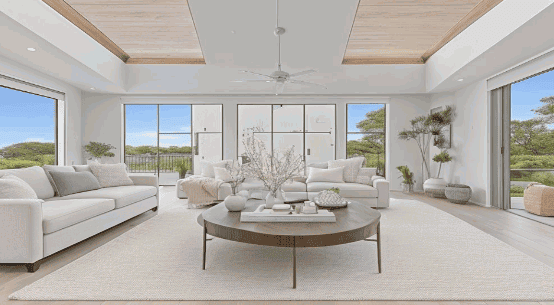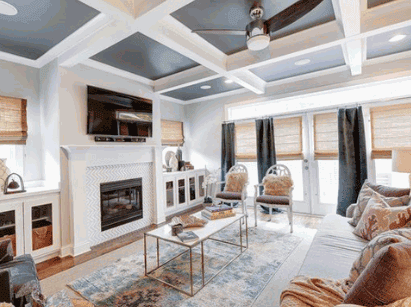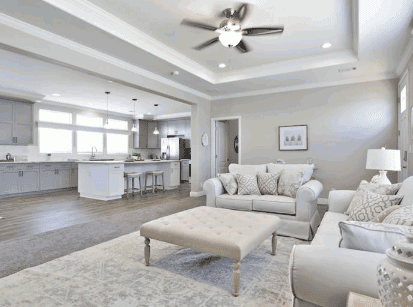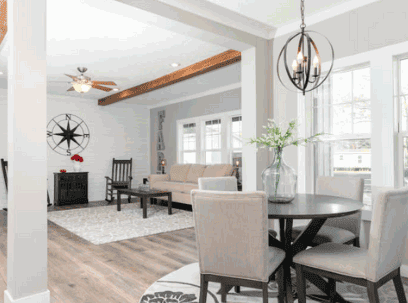
Ceiling height has a big influence on a room. It can make a place feel bigger and more airy, or smaller and more cozy. Its purpose is important too. For instance, taller ceilings are often chosen for commercial spaces like restaurants or offices, as they can fit lighting and ventilation systems. Lower ceilings may be better for areas that require privacy, such as bathrooms or bedrooms.
Architectural features and structural limits can also be a factor. Older buildings are likely to have lower ceilings due to design or historical reasons. Modern buildings, however, usually have higher ceilings, as part of current trends.

Table of Contents
Ceiling height is the distance between the floor and the ceiling in a room or building. It's very important for design and functionality. It affects how spacious a room feels and also things like lighting, ventilation, and acoustics.
Higher ceilings give a sense of grandeur and openness. They allow large windows, chandeliers, and artwork to be installed. Lower ceilings create a cozier atmosphere, perfect for rooms like bedrooms or offices.
Ceiling height also has practical implications. Higher ceilings mean more air circulation and natural light. This is great for rooms where people spend a lot of time, like living rooms or offices.
In NYC's Grand Central Terminal, an engineer wanted an impressive mural painted on the ceiling of a main chamber. But there wasn't enough space, so he asked for it to be shortened by 6 inches. Surprisingly, this small change caused commuters to be more likely to think negatively during their journeys.
Learn more: Can You Put Bed In Front Of Window
Local building codes often dictate the minimum ceiling height for different spaces. Residential buildings usually require 8 feet, while commercial ones may need higher heights based on their purpose.
The purpose and function of a space affect the best ceiling height. For example, living rooms may need higher ceilings to feel open. Oppositely, basements or storage rooms don't usually require a lot of height.
Different architectural styles also influence the choice of ceiling height. Modern designs often have higher ceilings to let in light. Traditional styles may opt for lower ceilings for coziness.
A person's individual preferences also matter when deciding the ceiling height.

Ceiling height is affected by various factors.
First, architectural design is key. Taller ceilings give a room a sense of openness and class, while shorter ceilings provide a snug and intimate vibe.
Second, building codes and regulations control the minimum required height for different spaces. For instance, residential needs are 7 feet or higher, and commercial buildings may require greater heights for safety and style.
Third, structural limitations may limit the achievable ceiling height. The construction method and materials used can affect this, with load-bearing walls and beams restricting the vertical space.
Lastly, budget constraints also come into play. Taller ceilings usually involve more materials and labor costs.
In conclusion, the height of a ceiling is determined by architectural design, building regulations, structural limitations, and budget restrictions.
For example, the Notre Dame Cathedral in Paris from the 12th century had exceptionally high ceilings, which added magnificence and left enough space for stained glass windows. This creative use of height continues to astonish visitors.
The height of ceilings is a captivating element of design that combines functionality and aesthetics. Knowing the factors affecting ceiling height helps architects and designers make spaces both attractive and practical for their purpose.

Let's check out a table with recommended ceiling heights for various spaces. This is helpful for architects and designers wanting optimal proportions.
For example, living rooms and kitchens should have 8-9 feet ceilings. Bedrooms, offices, and gyms should have 8-10 feet and 15-20 feet, respectively.
In addition, vaulted ceilings can make a space seem bigger and grander. On the other hand, lower ceilings in some places like libraries and theaters can make it more cozy.
Historically, ceilings were usually higher than modern ones. This was due to aesthetic and functional needs then.
Interior design is not only about numbers and measurements. It involves considering the purpose of a space, personal preferences, and design elements.
Fact: 'Architectural Digest' notes that ceiling heights can affect how we perceive a room's size and atmosphere.
Getting the perfect ceiling height is key to an attractive space. To ensure success, do the following:
Knowing the details of attaining the desired ceiling height is important. Think about aspects such as lighting, HVAC systems, and soundproofing. By considering these, you can make a great-looking and practical space.
Reaching the desired ceiling height requires meticulous planning. Using these tips and getting professional help, you can make a beautiful space that meets your vision.

Scientists and architects have long sought the ideal ceiling height. They've looked at how people perceive it, lighting needs, and architectural styles. Ceiling height is crucial for interior design because it affects how a room looks and functions.
When deciding on the right height, human perception is key. Too low can make a room feel cramped and uncomfortable. Too high can make it impersonal and cavernous. The goal is to find a balance that creates a sense of openness.
Lighting is another factor to consider. Lower ceilings can create an intimate atmosphere but limit natural light. Higher ceilings let in more light, reducing the need for artificial lighting.
Architectural styles influence ceiling height too. Classical architecture prefers grand proportions, while modern minimalist designs favor simplicity. Following these conventions helps keep a building's design visually cohesive.
Throughout history, civilizations have showcased different ceiling heights in their architecture. Ancient Egyptian temples had elaborate ceilings to inspire awe. Medieval cathedrals had vaulted ceilings to symbolize spiritual ascent.